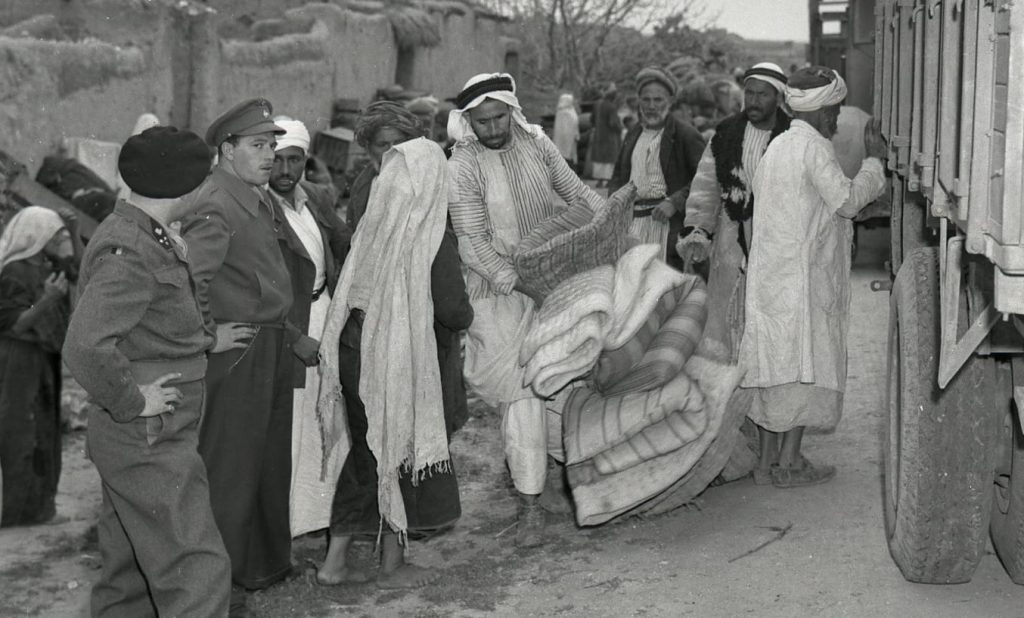In an article published in its weekend magazine section on Friday, July 5, the Israeli daily newspaper Haaretz revealed that since the start of the last decade, Defense Ministry teams have been scouring archives throughout Israel and removing “sensitive” historic documents. However, among the documents being transferred to secret vaults are not just papers relating to Israel’s nuclear project or to the country’s foreign relations. They also include hundreds of documents that have been illegally requisitioned and hidden away as part of a systematic effort to conceal evidence of the Nakba.

Ethnic cleansing after the guns fell silent, March 1949: The eviction of the residents of the village of Iraq al-Manshiyya, population 2,000, which had been within the borders of the Arab state defined by the 1947 UN Partition Plan of Palestine. This action took place weeks after Israel and Egypt signed their armistice agreement in Rhodes, Greece, under the auspices of the UN, setting the armistice line such that Iraq al-Manshiyya was on the Israeli side. The residents of the village were transferred to what would become known as the Gaza Strip. In 1954, Israel founded the development town of Kiryat Gat that included the site and adjacent agricultural fields of the erased Arab village, totaling some 1,350 hectares of land. (Photo: Collection of Benno Rothenberg / Israel State Archives)
This phenomenon was first detected by the Akevot Institute for Israeli-Palestinian Conflict Research. According to a report drawn up by the institute, the operation is being spearheaded by Malmab, the Defense Ministry’s secretive security department (the name is a Hebrew acronym for “director of security of the defense establishment”), whose activities and budget are classified. The report asserts that Malmab removed historical documentation illegally and with no authority, and at least in some cases has sealed documents that had previously been cleared for publication by the military censor. Some of the documents that were placed in vaults had already been published.
The investigative report published in Haaretz, last Friday, by the journalist by Hagar Shezaf found that Malmab has concealed testimony from IDF generals about the killing of civilians and the demolition of villages, as well as documentation of the expulsion of Arab-Bedouin during the first decade of statehood. Conversations conducted by Haaretz with directors of public and private archives alike revealed that the staff of the Malmab security department often treat the realm of archival materials in Israel as its own private fiefdom, and in some cases have even threatened the directors of the archives who refuse to hand over doeuments.
Yehiel Horev, who headed Malmab for two decades, until 2007, acknowledged to Haaretz that he launched the project, which is still ongoing. He maintains that it makes sense to conceal the events of 1948, because uncovering them could generate unrest among the country’s Arab population. Asked what the point is of removing documents that have already been published, he explained that the objective is to undermine the credibility of studies about the history of the refugee problem. In Horev’s view, an allegation made by a researcher that is backed up by an original document is not the same as an allegation that cannot be proved or refuted.
An officer in Shai, the precursor to the Shin Bet security service, wrote one of the most fascinating documents about the origin of the Palestinian refugee problem. It discusses why the country was emptied of so many of its Arab inhabitants, dwelling on the circumstances of each village. Compiled in late June 1948, it was titled “The Emigration of the Arabs of Palestine.”
This document was the basis for an article that the Israeli historian Benny Morris published in 1986. After the article appeared, the document was removed from the archive and rendered inaccessible to researchers. Years later, the Malmab team reexamined the document, and ordered that it remain classified. They could not have known that a few years later researchers from Akevot would find a copy of the text and run it past the military censors – who authorized its publication unconditionally. Now, after years of concealment, the gist of the document is being revealed here.
The 25-page document begins with an introduction that unabashedly approves of the evacuation of the Arab villages. According to the author, the month of April 1948 “excelled in an increase of emigration,” while May “was blessed with the evacuation of maximum places.” The report then addresses “the causes of the Arab emigration.” According to the Israeli narrative that was disseminated over the years, responsibility for the exodus from Israel rests with Arab politicians who encouraged the population to leave. However, according to the document, 70 percent of the Arabs left because of Jewish military operations.
The unnamed author of the text ranks the reasons for the Arabs’ departure in order of importance. The first reason: “Direct Jewish acts of hostility against Arab places of settlement.” The second reason was the impact of those actions on neighboring villages. Third in importance came “operations by the breakaways,” namely the Irgun and Lehi undergrounds. The fourth reason for the Arab exodus was orders issued by Arab institutions and “gangs” (as the document refers to all Arab fighting groups); fifth was “Jewish ‘whispering operations’ to induce the Arab inhabitants to flee”; and the sixth factor was “evacuation ultimatums.”
The author of the 25-page document asserts that, “without a doubt, the hostile operations were the main cause of the movement of the population.” In addition, “Loudspeakers in the Arabic language proved their effectiveness on the occasions when they were utilized properly.” As for Irgun and Lehi operations, the report observes, “many in the villages of central Galilee started to flee following the abduction of the notables of Sheikh Muwannis,” a village north of Tel Aviv, now Ramat Aviv, the site of Tel Aviv University.


